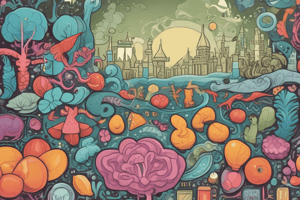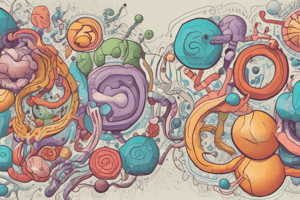Podcast
Questions and Answers
What is the primary function of proteins in the human body?
What is the primary function of proteins in the human body?
- To store genetic information
- To provide energy
- To facilitate metabolism, immunity, fluid balance, and nutrient transport (correct)
- To regulate body temperature
What are essential amino acids characterized by?
What are essential amino acids characterized by?
- They cannot be produced by the human body and must be obtained through diet (correct)
- They can be produced by the human body
- They are only found in plant-based foods
- They are only necessary for muscle growth
What is the process of converting genetic information from RNA to assemble amino acids in a specific sequence?
What is the process of converting genetic information from RNA to assemble amino acids in a specific sequence?
- Mutation
- Translation (correct)
- Gene expression
- Transcription
What is the term for the unique 3-dimensional shape of a protein?
What is the term for the unique 3-dimensional shape of a protein?
What happens to a protein when it loses its unique shape?
What happens to a protein when it loses its unique shape?
What is a complete protein?
What is a complete protein?
What is the term for combining two incomplete proteins to make a complete protein?
What is the term for combining two incomplete proteins to make a complete protein?
What are two protein sources that together supply all 9 essential amino acids?
What are two protein sources that together supply all 9 essential amino acids?
What is one of the reasons why we need proteins?
What is one of the reasons why we need proteins?
What happens to proteins in the stomach?
What happens to proteins in the stomach?
Who requires more protein?
Who requires more protein?
What is the recommended daily intake of protein?
What is the recommended daily intake of protein?
What is a risk of consuming too much protein?
What is a risk of consuming too much protein?
What is protein-energy malnutrition?
What is protein-energy malnutrition?
What is marasmus?
What is marasmus?
Why do some people adopt a vegetarian diet?
Why do some people adopt a vegetarian diet?
What is a challenge of a vegetarian diet?
What is a challenge of a vegetarian diet?
What is the role of vitamin B12?
What is the role of vitamin B12?
Which vitamin promotes cell growth?
Which vitamin promotes cell growth?
What is the primary function of iron in the body?
What is the primary function of iron in the body?
Which of the following is a characteristic of fat-soluble vitamins?
Which of the following is a characteristic of fat-soluble vitamins?
What is the main difference between macronutrients and micronutrients?
What is the main difference between macronutrients and micronutrients?
Which of the following is NOT a characteristic of water-soluble vitamins?
Which of the following is NOT a characteristic of water-soluble vitamins?
What is the primary function of calcium in the body?
What is the primary function of calcium in the body?
What is the primary function of zinc in the body?
What is the primary function of zinc in the body?
What is the main difference between micronutrients and macronutrients in terms of absorption?
What is the main difference between micronutrients and macronutrients in terms of absorption?
What is the daily requirement of major minerals in the body?
What is the daily requirement of major minerals in the body?
What is the total number of essential trace minerals in the body?
What is the total number of essential trace minerals in the body?
Which of the following factors can affect the absorption of micronutrients?
Which of the following factors can affect the absorption of micronutrients?
What is a potential risk of supplementing micronutrients?
What is a potential risk of supplementing micronutrients?
Which of the following minerals has been associated with a reduced risk of hypertension?
Which of the following minerals has been associated with a reduced risk of hypertension?
Which of the following substances may prove to be essential in the diet?
Which of the following substances may prove to be essential in the diet?
Study Notes
Proteins
- Critical molecules for metabolism, immunity, fluid balance, and nutrient transport
- Provide energy and are a form of nitrogen that the body uses
- Function: metabolism, immunity, fluid balance, and nutrient transport
Amino Acids
- Nitrogen-containing molecules that form proteins
- Essential amino acids: 9 out of 20, cannot be produced by the body, and must be obtained from food
- Nonessential amino acids: made by the body
Protein Synthesis
- 2 amino acids join to form a dipeptide through a peptide bond
- 10 or more amino acids bond together to form a polypeptide
- Proteins are made by combining multiple amino acids through transcription and translation
- Transcription: genetic information in DNA is copied to make RNA
- Translation: conversion of genetic information in RNA to assemble amino acids in the sequence to synthesize a protein on the ribosome
Protein Structure
- Primary structure: sequential order of amino acids
- Secondary structure: spiral shape due to chemical bonding between amino acids
- Tertiary and quaternary structure: folding into a unique 3-dimensional shape that may be globular or fibrous
- Denaturation: loss of protein shape due to heat, acids/bases, heavy metals, or alcohols, resulting in an irreversible loss in protein function
Protein Quality
- Incomplete protein: lacks essential amino acids in sufficient quantities, compromising growth and health
- Complete protein: contains sufficient amounts of all 9 essential amino acids, considered a "high-quality" protein
- Mutual supplementation: combining 2 incomplete proteins to make a complete protein
- Complementary proteins: 2 protein sources that together supply all 9 essential amino acids
Importance of Proteins
- Cell growth, repair, and maintenance
- Enzymes, hormones, and antibodies
- Fluid and electrolyte balance, PH balance, and energy source
- Transport and storage of nutrients
Protein Digestion and Absorption
- Stomach acids and enzymes break proteins into short polypeptides
- Digestion continues in the small intestine, where polypeptides are further broken down
- Pancreatic enzymes called proteases complete the digestion of proteins into single amino acids
- Protein digestibility affects protein quality
Protein Requirements
- Nitrogen balance: relationship between nitrogen consumption and excretion
- Recommended dietary allowance (RDA): 0.8 grams of protein per kilogram of body weight per day, 10-35% of total energy intake
- Certain groups require more protein: children, adolescents, pregnant or lactating women, athletes, and vegetarians
Protein Sources
- Animal protein sources (meat, dairy), soy products, and legumes are highly digestible
- Grains and veggie proteins are less digestible
- Legumes, nuts, and "new" foods (quorn, quinoa, amaranth, teff, millet, and sorghum) are alternative protein sources
Risks of Excessive Protein Intake
- High cholesterol and heart disease
- Kidney disease in people who are susceptible
- No evidence that high-protein diets lead to bone loss, except in people consuming inadequate calcium
Protein-Energy Malnutrition
- Disorder caused by inadequate intake of protein and energy
- Two most common forms: marasmus and kwashiorkor
- Marasmus: disease resulting from severely inadequate intakes of protein, energy, and other nutrients, characterized by extreme tissue wasting and stunted growth and development
- Kwashiorkor: disease resulting from extremely low protein intake, characterized by weight loss, muscle wasting, and edema, often seen in children in developing countries
Vegetarianism
- Restricting the diet to foods of plant origin
- Many versions and reasons to adopt a vegetarian diet, including health benefits, ecological, religious, ethical, and food safety concerns
Health Benefits of Vegetarianism
- Lower intake of fat and total energy
- Lower blood pressure
- Reduced risk of heart disease, certain types of cancer, and kidney disease
- Fewer digestive problems
Challenges of Vegetarianism
- Can be low in some vitamins and minerals (iron, calcium, zinc, vitamin D, and vitamin B12)
- Must plan a balanced and adequate diet
- Soy products are an excellent protein source
- Should include complementary proteins
Vitamins and Minerals
- Macronutrients: carbohydrates, fats, and protein, provide energy, require large amounts
- Micronutrients: vitamins and minerals, don't supply energy, small amounts, assist body functions, and may have low absorption rates
- Fat-soluble vitamins: A, D, E, and K, have large storage, toxicity, and deficiency symptoms may take months to develop
- Water-soluble vitamins: 9 vitamins, have minimal storage, toxicity is rare, and deficiency symptoms occur quickly
- Minerals: inorganic, can't be synthesized by plants/animals, 2 classifications based on need: major minerals (100mg/day required, 5g or higher in body) and trace minerals (less than 100mg/day required, body contains less than 5g)
- Absorption of micronutrients depends on factors: chemical form, food components, other nutrients, and supplementation
- Adequate intake of micronutrients has been associated with lowered disease risks
Studying That Suits You
Use AI to generate personalized quizzes and flashcards to suit your learning preferences.
Description
This quiz covers the basics of proteins, their functions, and importance in nutrition. Learn about amino acids, essential and nonessential ones, and how proteins are made.




